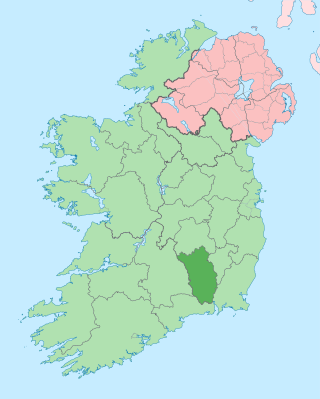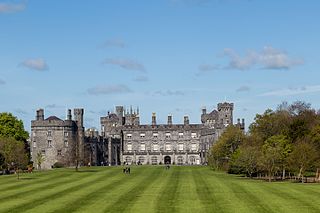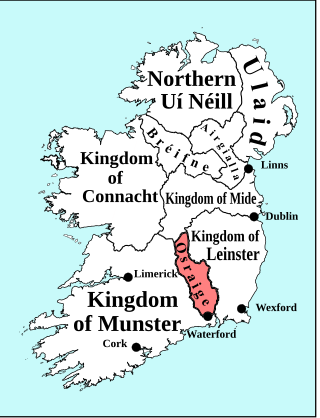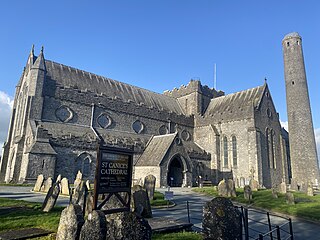
County Kilkenny is a county in Ireland. It is in the province of Leinster and is part of the Southern Region. It is named after the city of Kilkenny. Kilkenny County Council is the local authority for the county. At the 2022 census the population of the county was 103,685. The county was based on the historic Gaelic kingdom of Ossory (Osraighe), which was coterminous with the Diocese of Ossory.

Kilkenny is a city in County Kilkenny, Ireland. It is located in the South-East Region and in the province of Leinster. It is built on both banks of the River Nore. The 2022 census gave the population of Kilkenny as 27,184, the thirteenth-largest urban center in Ireland.

Graiguenamanagh or Graignamanagh is a town on the River Barrow in County Kilkenny, Ireland. Part of the settlement, known as Tinnahinch, is on the County Carlow side of the river, and Carlow County Council refers to the whole village as "Graiguenamanagh-Tinnahinch". Also combined for census purposes, as of the 2022 census, Graiguenamanagh-Tinnahinch had a population of 1,506 people. The town is in a townland and civil parish of the same name.

Thomastown, historically known as Grennan, is a town in County Kilkenny in the province of Leinster in the south-east of Ireland. It is a market town along a stretch of the River Nore which is known for its salmon and trout, with a number of historical landmarks in the vicinity. Visitor attractions include Jerpoint Abbey, Kilfane Glen gardens, and Mount Juliet Golf Course. The town is in a civil parish of the same name. As of the 2022 census, Thomastown had a population of 2,305, making the town the third most populous in the county.

The River Nore is one of the principal rivers in the South-East Region of Ireland. The 140-kilometre-long (87 mi) river drains approximately 2,530 square kilometres (977 sq mi) of Leinster and Munster, that encompasses parts of three counties. Along with the River Suir and River Barrow, it is one of the constituent rivers of the group known as the Three Sisters.

Castlecomer is a town in the north of County Kilkenny, Ireland. It is positioned at the meeting of N78 and R694 roads about 16 km (9.9 mi) north of Kilkenny city. At the 2016 census, Castlecomer had a population of 1,502 people. The town is in a townland and civil parish of the same name.

Ballyragget is a small town on the river Nore in the north of County Kilkenny in Ireland. Ballyragget is on the N77 road, 18 km (11 mi) north of Kilkenny. As of the 2016 census, it had a population of 1,082 people.

Osraige or Osraighe, Osraí, anglicized as Ossory, was a medieval Irish kingdom comprising what is now County Kilkenny and western County Laois, corresponding to the Diocese of Ossory. The home of the Osraige people, it existed from around the first century until the Norman invasion of Ireland in the 12th century. It was ruled by the Dál Birn dynasty, whose medieval descendants assumed the surname Mac Giolla Phádraig.

Inistioge is a small village in County Kilkenny, Ireland. Historically, its name has been spelt as Ennistioge, Ennisteage, and in other ways. The village is situated on the River Nore, 25 kilometres (16 mi) southeast of Kilkenny. Inistioge is in a townland and civil parish of the same name.

Bennettsbridge is a village in County Kilkenny in Ireland. It is situated on the River Nore 6 kilometres (3.7 mi) south of Kilkenny city, in the centre of the county. Bennettsbridge is a census town, and had population of 745 as of the 2016 census.

Rothe House is a late 16th-century merchant's townhouse complex located in the city of Kilkenny, Ireland. The complex was built by John Rothe Fitz-Piers between 1594–1610 and is made up of three houses, three enclosed courtyards, and a large reconstructed garden with orchard. As a museum, it is accessible to the public.

Mereworth Castle is a grade I listed Palladian country house in Mereworth, Kent, England.

Kilkenny marble or Kilkenny black marble is a fine-grained very dark grey carboniferous limestone found around County Kilkenny in Ireland in the "Butlersgrove Formation", a Lower Carboniferous limestone that contains fossils of brachiopods, gastropods, crinoids and corals. The first and main source was the "Black Quarry" in the townlands of Archersgrove and Gallowshill just south of Kilkenny city, which was used from the 17th to the 19th century. Kilkenny is nicknamed "the Marble City"; the footpaths of the city streets were paved with Kilkenny marble flagstones, which were highly polished with wear and glistened when wet.

The Bridge of Tiberius, historically also the Bridge of Augustus or the Bridge of Saint Julian, is a Roman bridge in Rimini, in the region of Emilia-Romagna, northern Italy.

Goresbridge is a small village located in the east of County Kilkenny, in the province of Leinster, Ireland. Goresbridge is named after a 1756 bridge, built by Colonel Ralph Gore, which provides a crossing of the River Barrow between County Kilkenny and County Carlow in the South-East region.

St Canice's Cathedral, also known as Kilkenny Cathedral, is a cathedral of the Church of Ireland in Kilkenny city, Ireland. It is in the ecclesiastical province of Dublin. Previously the cathedral of the Diocese of Ossory, it is now one of six cathedrals in the United Dioceses of Cashel and Ossory.
The medieval lost town of Newtown Jerpoint is just west of the Cistercian Jerpoint Abbey, near Thomastown, County Kilkenny, Ireland. It is located 3.2 km south west from Thomastown just off the R448 regional road. In the grounds of the privately owned Jerpoint Park. St. Nicholas’s Church and graveyard are in the town, where the earthly remains of St. Nicholas of Myra are said to be buried. Belmore House stands at the top of the town.

The tomb of Saint Nicholas is a slab effigy in low relief of an early 4th-century ecclesiastic popularly associated with Saint Nicholas of Myra in County Kilkenny, Ireland. While more probably a local priest from Jerpoint Abbey, it lies in the medieval lost town of Newtown Jerpoint, just west of the Cistercian Jerpoint Abbey.
John Bradley was a historian and archaeologist at NUI Maynooth. He grew up in Kilkenny and published many papers about his hometown.

Highhays Ware is a term used for medieval pottery produced at the Highhays pottery site in Kilkenny, Ireland. It was previously referred to as "Kilkenny-type ware". The pottery found during the excavations at the site included jugs, cooking pots, storage jars, money boxes, parts of pottery like spouts and ridge tiles or parts thereof, in total "42 sherds of [...] pottery and 160 ridge-tile fragments" from the kiln alone.






















